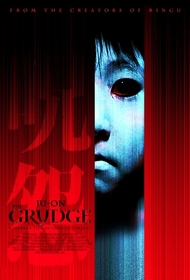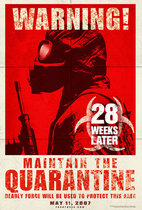Our editor-in-chief Nate Yapp is proud to have contributed to the new book Hidden Horror: A Celebration of 101 Underrated and Overlooked Fright Flicks, edited by Aaron Christensen. Another contributors include Anthony Timpone, B.J. Colangelo, Dave Alexander, Classic-Horror.com's own Robert C. Ring and John W. Bowen. Pick up a copy today from Amazon.com!
Ju-on: The Grudge (2003)
Perhaps our shiny new century's first significant horror trend was sparked by the cult success of a Japanese film entitled Ringu. Its decidedly non-conventional approach seemed to hit a new and different horror nerve. When the Americanized remake (2002's The Ring) became a colossal international hit a surge of interest in East Asian horror films ensued, allowing US audiences to sample their diverse and fascinating output. The subject of this review, Ju-on: The Grudge, presents a modern ghost story that dispenses almost completely with certain horror elements codified in the US while focusing on others with laser like intensity. This mixture creates a film that is a stylistic breath of fresh air that also happens to be one creepy experience.
A short prologue depicts a visibly disturbed and blood splattered man (Takeo Saeki), his murdered wife (Kayako), his son (Toshio), and family cat. The implication is clear that Takeo is in the process of killing his family. This act gives birth to a Ju-on, which roughly translates to "cursed grudge". Anyone who comes in contact with their house is haunted by the Saeki family ghosts and marked for death.
That may be the shortest synopsis of a film I will ever write. Its stark simplicity begs the question, "Can this concept support a feature length movie?" The answer lies in director Takashi Shimizu's decision to go all in on one of the bedrock values of horror. Before we go there I will list Shimizu's stylistic discards. Some American viewers may miss them but for the most part their absence improves the final product.
Even though there are plenty of victims taken by Kayako and company throughout the film, there is no graphic violence. There are no action sequences. The ghosts either pop up suddenly or advance very slowly. I'm talking 1940s Universal Mummy slow. There is no sex. There is no true protagonist and very little character development. The plot, told in a series of short vignettes, is a non-linear, time jumping maze that is nearly impossible to decipher on the first viewing. It has an ending that is so inscrutable that the US remake (entitled The Grudge) dropped it altogether. Lastly, Ju-on :The Grudge does not have a single post-modern, ironic bone in its body. You can think of it as the anti-Scream. Its tone is serious, even somber.
The absence of these reliable genre components has a liberating effect. Shimizu's goal is to draw us into his movie by delivering one thing -- an atmosphere of anticipatory dread that is as implacable as Kayako's curse. And for the entire 92 minutes of the film he does just that. Anything that distracts from this purpose does not make the cut. By the time the victim count nears double digits you might think that the film would begin to lose steam. But Shimizu's is so good at finding different ways to keep the audience on edge until the next encounter that we never notice.
A great strength of Ju-on: The Grudge is that the hauntings are not bound to the Saeki house. The ghosts appear in places where the victim is naturally vulnerable such as a public bathroom, under their bed covers, in the shower, and most creepily, from inside a victim's own body. This also allows the ghosts free reign to subvert modern technology. They often orchestrate bizarre meltdowns of cel phones, TV, photography, and surveillance cameras to foreshadow their next attack.
Shimizu also cleverly employs visual misdirection throughout the film. While the camera focuses on the action of characters situated in the foreground of a scene, Toshio is often introduced almost subliminally. When a just traumatized character named Hitomi tries to escape to her 5th floor apartment it is shot from inside the ascending elevator. We are shown the ghost boy Toshio in the background outside the elevator window as it passes each floor, silently peering in at the oblivious Hitomi. Another example occurs as Rika, a community volunteer, is transporting an elderly patient in a wheelchair who is playing peek-a-boo with an invisible someone. As she rolls the wheelchair back into the Community Center the glass door opens to reveal a brief reflection of Toshio. Like the moment at the end of Psycho when the skull is momentarily superimposed on Norman Bates it is so fleeting that it is easy to question whether you actually saw it. This sensitizes us to begin looking for the ghosts everywhere and once we start anticipating that something scary can happen at any time we are doing Shimizu's job for him.
Another advantage for Ju-On: The Grudge is that it does not follow the typical story arc of a western ghost story / horror film. This would typically consist of three stages:
General disbelief that the events happening in the story have a supernatural explanation.
Acceptance paired with an attempt to "figure out" the ghosts and what they want.
Action that leads to the elimination or at least appeasement of the spirits.
East Asian culture is much more receptive than the US to the idea of the existence of ghosts. Perhaps this comment by Koji Suzuki, the author of Ringu, says it best:
"In America and Europe most horror movies tell the story of extermination of evil spirits. Japanese horror movies end with a suggestion that the spirit still remains at large. That's because the Japanese don't regard spirits only as enemies, but as beings that co-exist with this world of ours."1
In Ju-On: The Grudge the disbelief phase does not exist and acceptance is a given. Even the detectives investigating the deaths and disappearances never offer an alternative explanation or express doubt that the victims' stories are true, It quickly becomes clear that there will be little screen time spent trying to communicate with the ghosts (Poltergeist) or vanquish them via science (Legend of Hell House). The only character who tries to fight back is Toyama, a detective who worked on the original Saeki murders. When he makes a desperate attempt to burn down the Saeki house Kayako makes a most terrifying entrance that sends him literally screaming into the night.
Shimizu does not want to analyze the curse, explain the ghosts, or provide a tidy climax with a Hollywood ending. He wants us to experience the curse and the ghosts emotionally. As Oxide Pang, co-director of the excellent Hong Kong export, The Eye (2002), says,
"With a scary (Asian) movie when the audience comes out of a theater, all that matters is whether it's scary. No one says, this movie is so cool. It's so reasonable."2
Ju-on: The Grudge is missing a lot of what an American audience expects from a horror film. However, taken on its own "unreasonable" terms it contains plenty of what every good horror movie needs. Watch Ju-on: The Grudge by yourself in a dark room. When that third hand emerges from Rika's scalp while she is showering or the ghostly Kayako starts her bloody, contorted crawl down the Saeki house's stairway you won't be thinking about lapses in logic or the lack of a central character. I think you will be right where Mr. Shimizu wants you.
1From
an interview in the Winter 2005 Edition of Kateigaho International
Edition / Japan's Art and Culture Magazine
2Hodgman,
John. "The Haunting". NYTimes.com July 23,2006 / pg. 9









I really love this movie. One
I really love this movie. One of the best movies I ever saw.
Thanks for the comment. I
Thanks for the comment. I think it is one of the best examples of the Asian horror style that I have seen.
best,
Rich Dishman